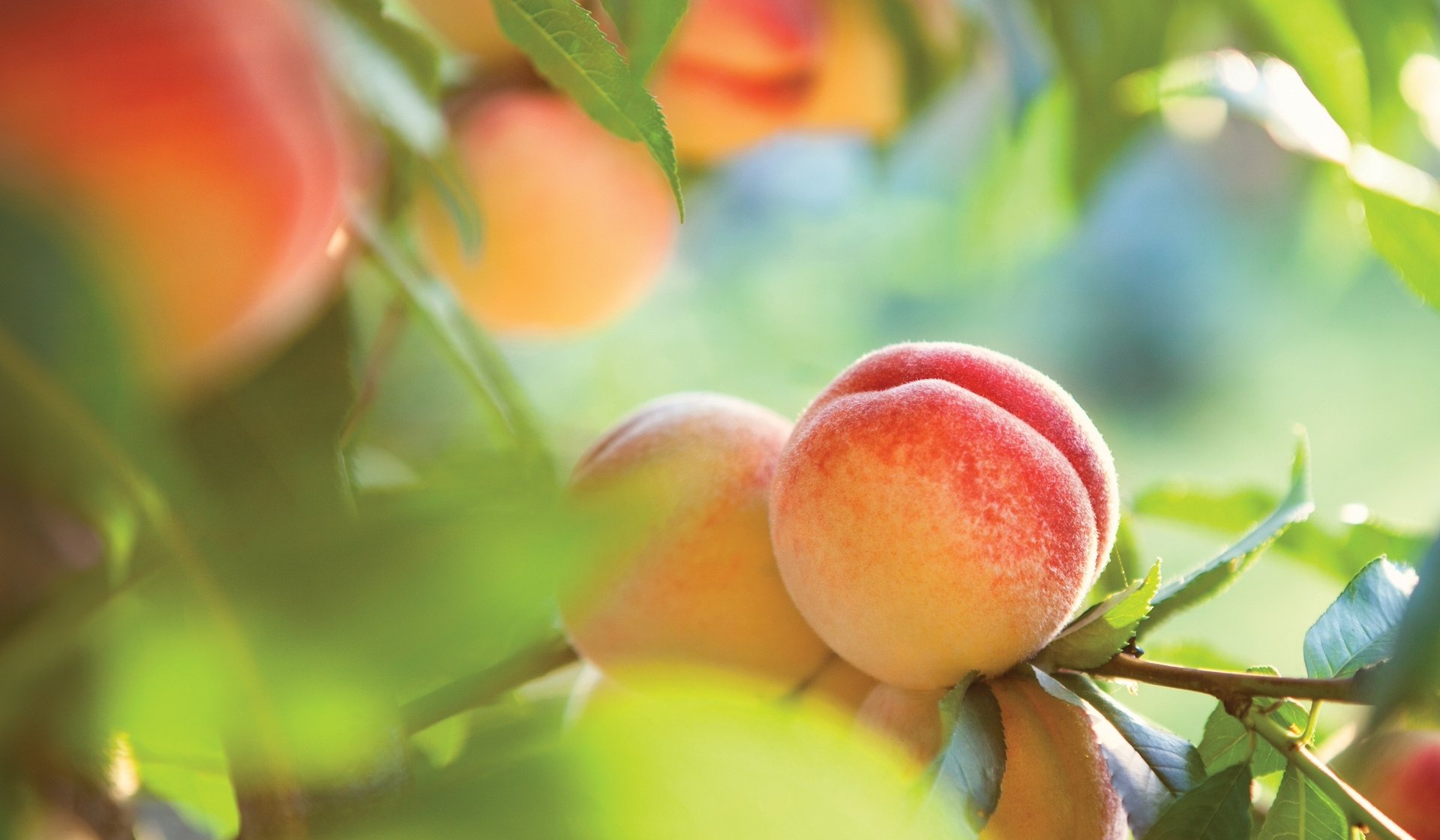In Praise of Peaches
The modest peach enjoys a long-standing place in Georgia’s culture and history.
During its midsummer season, Georgia is freckled with farmers markets and fruit stands selling one, or multiples, of the state’s different varieties of peaches. Year-round, the peach symbol is emblazoned on everything from state mugs to parade floats. Georgia, however, isn’t the nation’s biggest producer of the fruit; which begs the question, how did its peaches become so iconic?
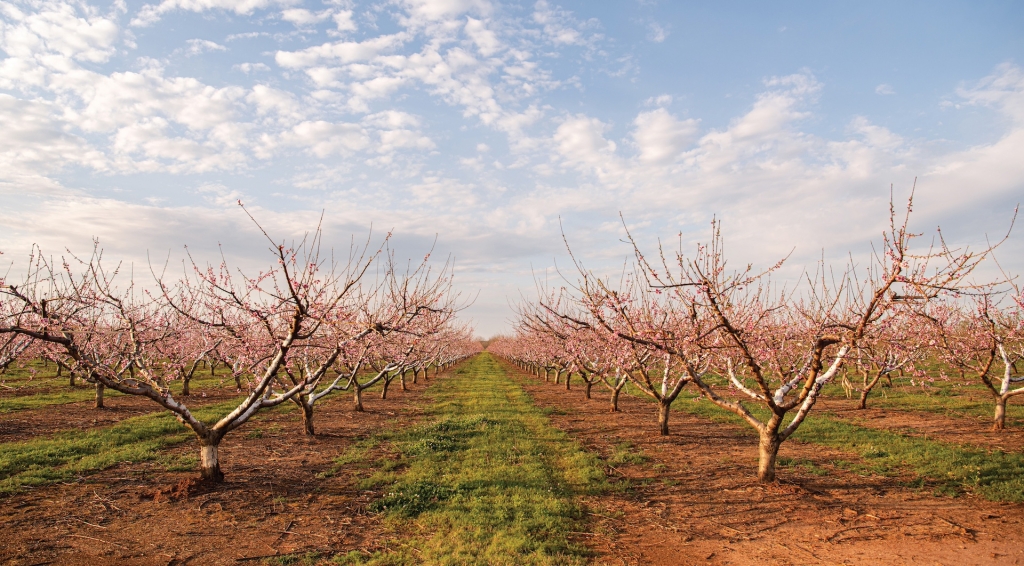
At Pearson Farm, the beginning of every peach season starts with blooming trees (above) and ends with fruit-bearing trees (below), ready for harvest.
WHERE PEACHES GROW
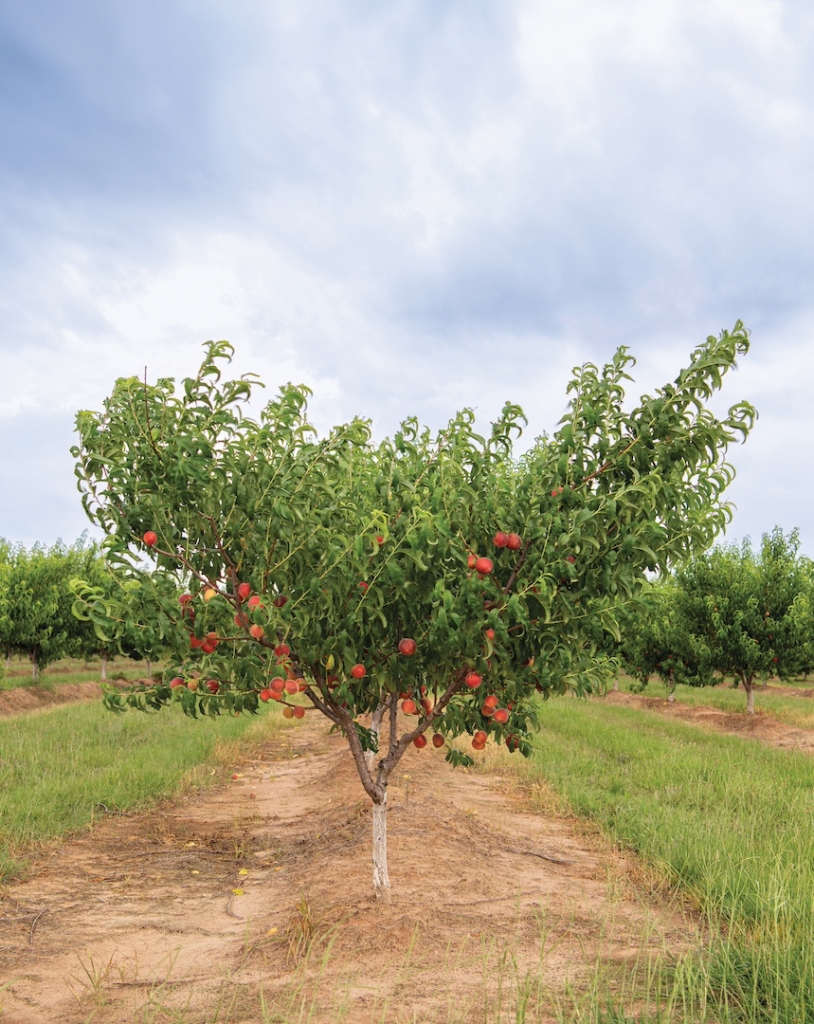 Peach pits, historically also known as “stones,” have been particularly helpful in tracing early civilizations, including the fruit’s origins in East Asia. The wrinkly, hard husk that houses the kernel from which the peach tree grows, has been found in the remains of Yangtze River Valley villages, circa 6000-5000 B.C., and has long weaved its way into China’s mythical and literary lore. A famed Chinese fable, The Peach Blossom Spring, written in 421 A.D. by Tao Yuanming, describes a fisherman discovering a mystical peach tree forest that shelters an isolated, idyllic village. Sau, the Chinese god of longevity, is typically depicted holding a peach. Within Chinese culture, every part of the peach tree holds power, including the ability to repel evil and entice love. To the Chinese, the fruit represents a long, healthy life of luck.
Peach pits, historically also known as “stones,” have been particularly helpful in tracing early civilizations, including the fruit’s origins in East Asia. The wrinkly, hard husk that houses the kernel from which the peach tree grows, has been found in the remains of Yangtze River Valley villages, circa 6000-5000 B.C., and has long weaved its way into China’s mythical and literary lore. A famed Chinese fable, The Peach Blossom Spring, written in 421 A.D. by Tao Yuanming, describes a fisherman discovering a mystical peach tree forest that shelters an isolated, idyllic village. Sau, the Chinese god of longevity, is typically depicted holding a peach. Within Chinese culture, every part of the peach tree holds power, including the ability to repel evil and entice love. To the Chinese, the fruit represents a long, healthy life of luck.
From China, the peach moved to India, then Persia (now Iran), followed by Europe. Franciscan monks, traveling to St. Augustine, Florida brought along peach pits in 1571. The seeds were easily preserved and transported—and Native Americans found the fruit responded well to southeastern soil and climate. People began growing the beautiful delicacy for their own use, but, according to the Georgia Historical Society, “peaches themselves could not be immediately commercialized because their fragility makes them easily bruised.” Growing a product that was unmarred, tasty, and shippable remained a challenge.
It wasn’t until the 19th century that the fruit became more than a backyard bounty or a delicious find in the wild. Two early Georgians contributed to making the peach a viable agricultural product: Columbus planter Raphael Moses and Marshallville farmer Samuel Rumph. Between 1858 and 1860, Moses first brought Georgia peaches to New York, protecting the fruit with champagne baskets. Packed in the baskets, the peaches arrived with better flavor and in better shape than those shipped in the previously prevalent packing material of the time: pulverized coal. More tender loving care of peaches came in 1875 when, Rumph, the “Father of the Georgia Peach Industry,” designed iced rail cars and peach crates for more protected transport. He never patented either so that others benefitted from his creativity. Rumph also produced the “Elberta,” a peach variety he named in honor of his wife, that crossed two popular peach varieties, the Early Crawford and Chinese Cling. The Elberta softened more slowly than other varieties, giving it the extra shelf life necessary for shipping.
“The thousands of peach varieties that exist today were developed for two primary reasons,” says Phillip Brannen, Fruit Extension Plant Pathologist for Georgia. “One is taste and he other is the fruit’s aesthetics.” He adds that peach variety research also focuses on effective growth, fighting disease, and insect infestation.
GEORGIA’S PEACHY CLAIM TO FAME
In the 1850s, out of a focused effort to build the fruit industry in the Southeast, the Georgia State Horticultural Society settled on the peach for promotion. In 1876, much of the society’s efforts provided an early link that connected Georgia’s image with the fruit.
Today, the state is the third largest U.S. peach producer behind California and South Carolina. Annually, Georgia produces typically 140 million pounds of peaches, earning in the $30 million to $40 million range. Peach County, located in central Georgia, produces about half of these. Formed from parts of Houston and Macon, Peach County was designated by legislature in 1924 and is the last new county to be established by the state.
The name is apt. “The main commercial band for peaches is in the center part of the state,” says Pam Knox, director of the University of Georgia Weather Network and agricultural climatologist. “That’s where probably 90% of the commercial peaches grow in Georgia. We have enough cold weather there that producers can make their “chill hour” requirements. Chill hours are a measure of how many hours are below 45 degrees,” she says. Some cold time is necessary to grow peaches.
When Georgia adopted the “Peach State” sobriquet in 1995, officials cited the fruit’s “superior flavor, texture, appearance and nutritious qualities” as evidence that the title was deserved. The peach symbol abounds within the state, on license plates, billboards, government documents, the state quarter, the state map, and even the peach-shaped ball that historically drops during Atlanta’s New Year’s Eve celebration. Peach streets, peach parades, and peach festivals thrive, the largest being the week-long Georgia Peach Festival held each June in Fort Valley and Byron. It draws thousands and includes peach queens, a peach eating contest, and the world’s largest peach cobbler. Growers associated with the festival include three major area peach operations: Dickey Farms in Musilla and Lane Southern Orchards and Pearson Farm, both in Fort Valley.
BUSHELS OF FUN
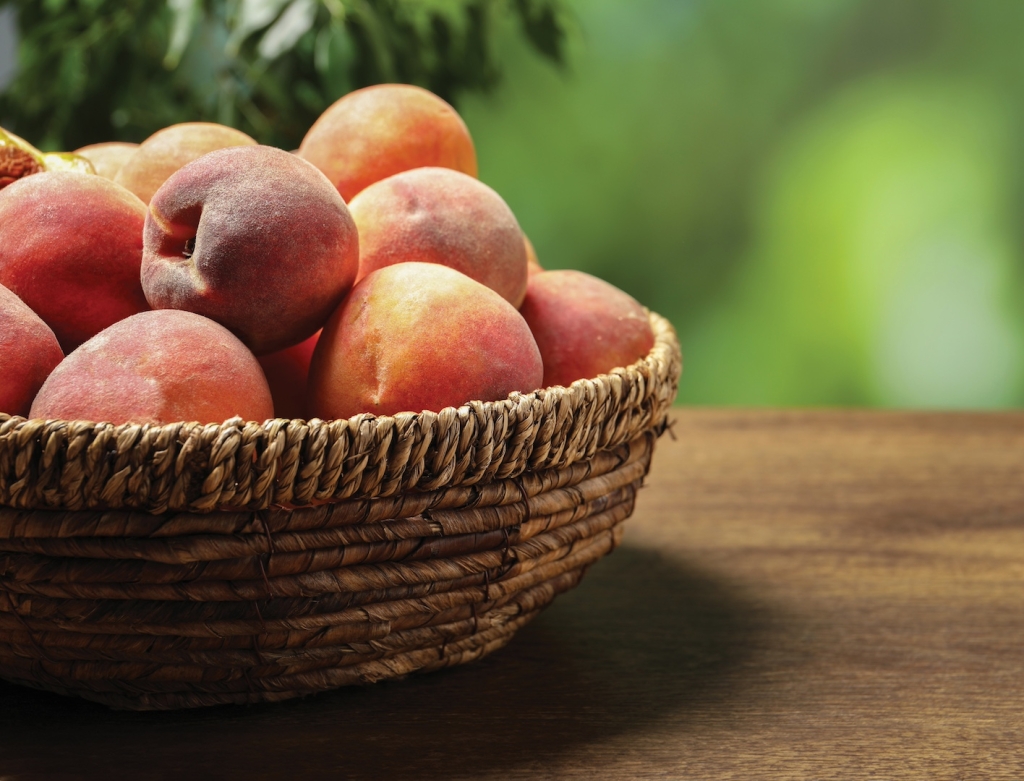
Summertime in Georgia means one thing: peach season. Every May to September, farms open their gates to fans who are ready to get some hands-on action. Wind your way around the state, where you can find bushels of juicy peaches and peach-flavored treats.
Located in Alto, a town in northeastern Georgia, Jaemor Farms planted its first peach trees in 1912. If you visit the farm for their annual “U Pick Peaches” day, try beloved items like peach cobbler, peach tea, and their famous peach pudding. In central Georgia, pick your own peaches or try a slice of peach bread at Dickey Farms in Musella—which bills itself as the oldest peach-packing house in Georgia. Taylor Orchards, located in the heart of Georgia’s famous peach belt, is a family-owned farm that boasts 3,600 acres of peaches and over 30 different varieties.

A glimpse above as peach farmers harvest their orchard’s crop.
WHERE PEACHES GROW
Pearson Farm is a large family-run peach producer in Georgia, growing about 50 varieties. Lanier Pearson handles marketing operations for the farm, while her husband, Lawton, represents the family’s fifth generation and is hands-on in production. “There’s a reason Georgia is called the Peach State,” says Lanier, “our peaches are just better.”
Wendy R. Barton, Lane Southern Orchards’ marketing director, agrees and describes Georgia as the peachiest of peach producers, calling the state “the Southern belle of peach season.” Located in Fort Valley, Lane Southern Orchards is another large peach operation in Peach County and has been in business for more than 100 years. Today, the century-old farm grows over 35 varieties and acts as dedicated ambassadors of peaches, not only about peach-producing Georgia, but other states’ peach farming work as well.
Because various states have vastly different climates, peach season changes from state to state. Georgia, however, is able to produce peaches earlier than most other peach-growing states due to the state’s warm climate. Typically, the first peaches grown in Georgia are ready as early as mid-May. As a general rule, peach trees are shaped and orchards are cleaned in the fall. Pruning times vary slightly. For some, pruning is conducted in December and throughout January. The Pearson Farm, for instance, begins pruning primarily at the end of January.
“There’s a lot of research on how to grow peaches more effectively,” notes Brannen. “There’s a real interest in growing trees that are smaller and shorter that you can pick more easily.” Peach trees tend to naturally grow about 21 to 25 feet but cultivated ones are kept to 10 to 15 feet through annual pruning done by hand. Branches are winnowed to allow optimum airflow, sunshine and reachability. Dead or damaged branches are removed, while the branches that remain are pruned to form a vase shape, approximately 45 degrees from the trunk.
“One branch will have dozens of flowers on it. Each flower is a peach,” says Lanier. The trees must be thinned by hand. Around May 15, the first harvest begins and continues through mid-August. “There are not many peach farms around and there’s a reason for that,” she says of the labor-intensive crop. “Growing peaches is really more of an art than a crop. We make the claim that we can grow better peaches than anyone because of the geography. We may not grow the most, but we grow the best.”
Peaches are a lucrative but fragile crop. To thrive, peaches need the right temperature at the right time. Too much cold and the flowers die; too much warmth makes the trees produce early, perhaps to be wiped out by subsequent freezes. Several options are used to prevent freezing decimation, including burning hay bales, wind machines, and even low-flying helicopters to stir up warm air. “You can do everything right and then in one night, you can lose an entire crop,” says Lanier.
GOOD EATING
Georgia peaches, for good reason, are served in some of the nation’s top restaurants. The state’s produce is shipped both nationwide—to kitchens at restaurants such as The French Laundry in California and Per Se in New York City—and regionally, in Hugh Acheson’s Georgia restaurants and Ardsley Station, a neighborhood eatery located in Savannah, Georgia.
Opened in 2021, Ardsley Station credits its local roots for the restaurant’s well-received menu. “The restaurant serves Georgia peaches when they’re at peak season,” says Tyler Kopkas, owner and operating partner for Ardsley Station. “Nearby sources are always the best. You don’t get the same flavor from peaches being grown year around and shipped in from across the globe.” His Georgia supplier “picks them at the perfect point when they’re on the tree, puts them in boxes, and sends them our way. By the time they arrive at our front door, they’re at peak ripeness. In other words, we receive a peach that tastes like a peach.”
The fruit is used as a sweet topper for the restaurant’s popular pimento cheese bruschetta. “We slice the peaches very thin and rest them on top of the salty cheese pimento,” he says. During season, peaches are also used for a chutney on pork chops, a cobbler, a crisp, in a barbecue sauce, and on the restaurant’s dayboat catch entrées.
As an ingredient, peaches fit virtually every dining opportunity imaginable, from sweet to savory, and from the most complex to the simplest recipe. Chef Adam Thomas, executive pastry chef for Sea Island, appreciates the fruit’s versatility. “Peaches might be my favorite fruit,” he says. He acknowledges how they can be used in myriad ways, for any meal throughout the day, and even as a delicious snack, or in a dessert, smoothie, or cocktail.
The fruit can also be a healthy choice. “Along with being sweeter and juicier than other peaches, Georgia peaches boast excellent nutritious qualities,” Lane Southern Orchard’s Barton notes, citing peaches as a means for people to maintain “a healthy, well-balanced diet with natural minerals and vitamins.”
With all of these qualities possessed by peaches, Brannen has faith that producers will keep growing Georgia’s favorite fruit. “Humans have been eating peaches for several thousand years now,” he says, citing a recent visit to Pompeii in Italy where peach pits were discovered among the volcano-covered remains. “I assume we’ll keep doing it.”
A PEACH DELIGHT
With Chef Adam Thomas
As a recent resident to Georgia, Sea Island Chef Adam Thomas happily anticipates becoming more familiar with the state’s peach offerings. “I really look forward to the late summer stone fruit season. In Georgia, I know there are a lot of different varieties,” the resort’s executive pastry chef says. “They’re versatile and they’re good on their own. There’s nothing like biting into a fresh peach.”
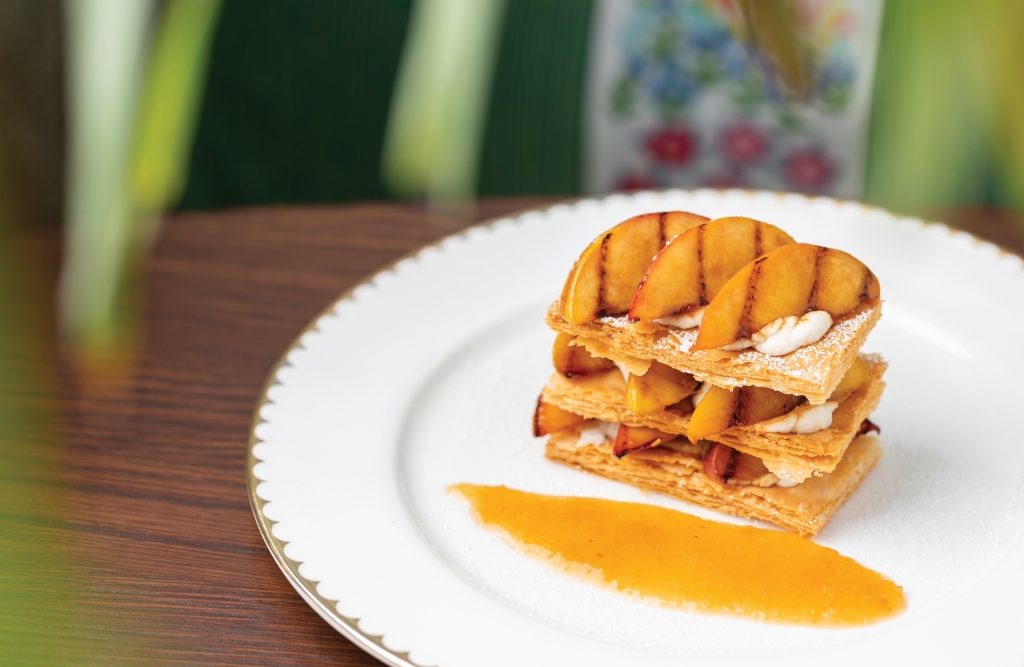
Thomas has had the opportunity to use peaches in countless recipes. “We’ve used the preserves for fresh-fried doughnuts,” he says. “We’ve taken peach pulp and made it a refined purée for a fruit jelly. We’ve done ice cream sorbet. It’s really just such a delicious fruit to play with.”
A spin on the classic French puff pastry dessert, a grilled peach mille feuille (left) feels quintessentially like summer with homemade mascarpone cream and hints of vanilla. According to Thomas, however, the real trick to getting this dish right is using beautifully ripe, Georgia peaches.
GRILLED PEACH MILLE FEUILLE
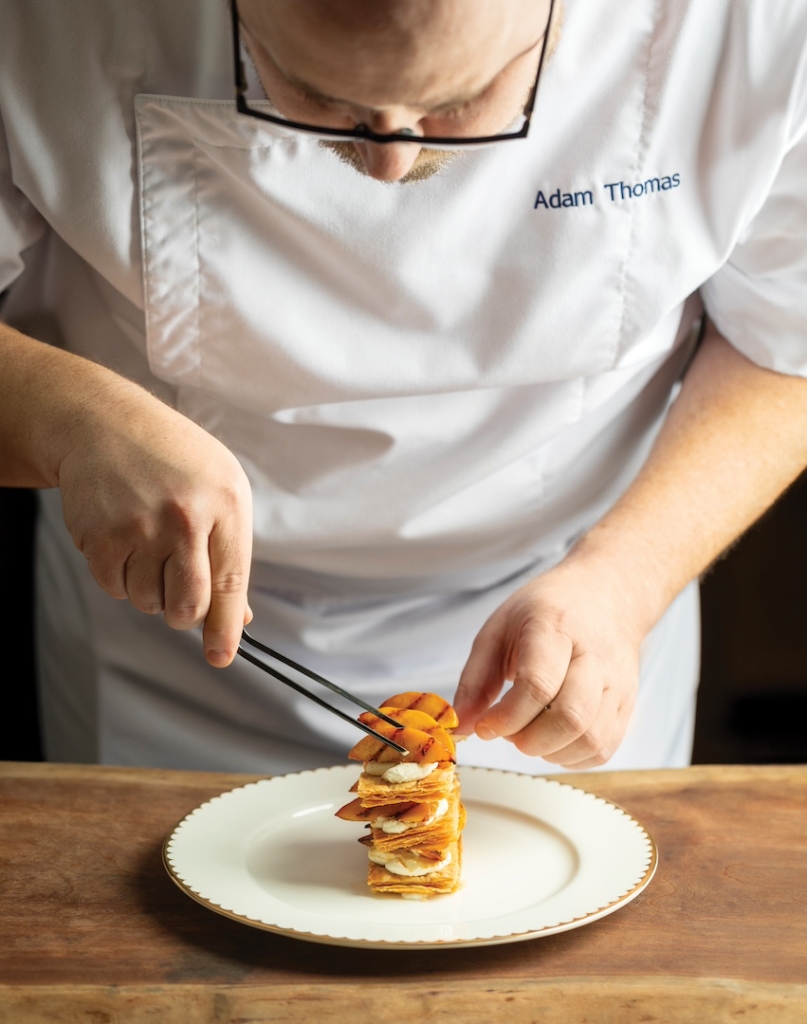
Prep Time: 30 mins
Cook Time: 30 mins
Yields: 3 servings
GRILLED PEACHES
4 large Georgia peaches, ripe
1/4 cup brown sugar
juice of 1/2 lemon
1 vanilla bean
3 ounces bourbon
MARSCAPONE CREAM
1 cup mascarpone cream
2 cups whipping cream
1 vanilla bean
2 tablespoons powdered sugar
juice of 1/2 lemon
PUFF PASTRY
1 package puff pastry sheet
FOR THE PEACHES
Cut peaches into eighths. In a medium-sized bowl, toss peaches with sugar, lemon juice, vanilla, and bourbon. Reserve for 15 minutes.
Prepare your grill, ensuring the grates are cleaned and oiled. Over medium grill heat, place peaches flesh side down, directly on grates. After three minutes, flip peaches and grill for another three minutes.
Remove peaches and drizzle with bourbon.
FOR THE MASCARPONE CREAM
Add mascarpone cream, sifted powdered sugar, vanilla, and lemon juice into a tabletop mixer. Using the paddle attachment, paddle the mixture until combined. Remove from the mixer and set aside.
Using the whip attachment, mix whipping cream until soft peaks form. Carefully fold the whipped cream into the mascarpone cream mixture.
Place combined cream into a piping bag with a medium-sized star tip. Reserve in the cooler.
FOR THE PEACHES
Using pre-laminated puff pastry sheets, place dough on a parchment-lined sheet pan. Cover dough with a second piece of parchment and place a second sheet pan on top. Bake the puff pastry at 120°F for 15 minutes. After 15 minutes, remove the top pan and parchment paper. Bake for an additional 10 minutes. Remove from oven.
Using a sifter, evenly shake powdered sugar over puff pastry sheets. You should have a well-caramelized puff pastry with a slight shine on top. Once the puff pastry is cool, using a serrated knife, cut into 2” x 3” rectangles. This should yield roughly nine rectangles.
PLATING
Place one rectangle of puff pastry dough in the center of a dessert plate. Generously pipe mascarpone cream mixture over the puff pastry. Place three slices of grilled peaches on top of the cream. Place a second rectangle of puff pastry on top of the peaches and repeat process for a total of three layers.
Garnish plate with a smear of blended fresh peach and dust with powdered sugar.




